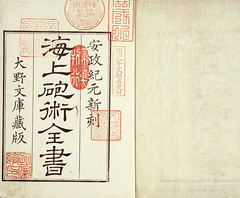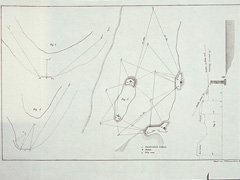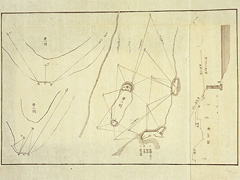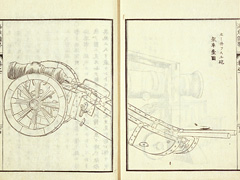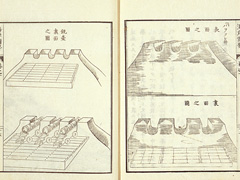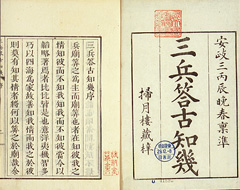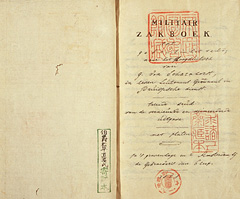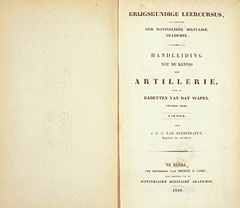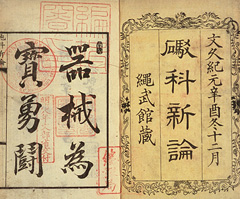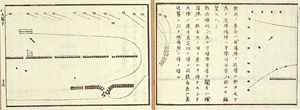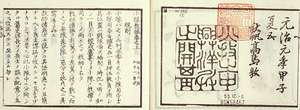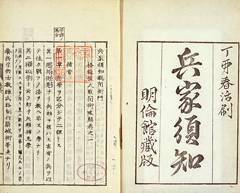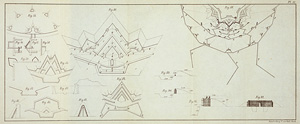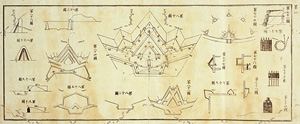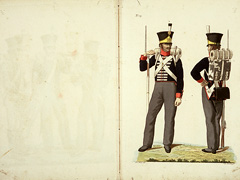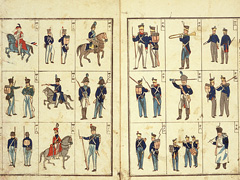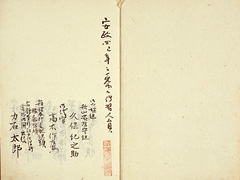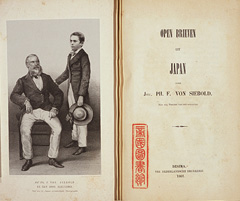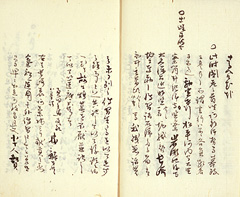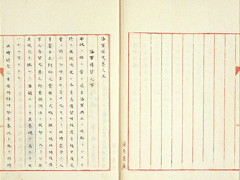This is the Japanese translation of the Dutch book Taktiek der drie wapens; infanterie, kavalierie en artillerie (1837) that is the translation of Grundzuge der Taktik der drei Waffen (1833), a book on warfare strategy by Prussian Heinrich von Brandt. 'Sanpei' means infantry, cavalry, and artillery, and 'takuchiki' means military tactics. This was said to have been translated in Uwajima where translator Takano Choei lived after escaping imprisonment in Bansha no Goku Affair (1839).
Home | Part 2: View by Topics | 5. Acceptance of Western Military Science at the End of Edo Period
Part 2: View by Topics
5. Acceptance of Western Military Science at the End of Edo Period
Japan began receiving Western military science during the late Edo period in response to the disquiet permeating East Asia, the attack on Etorofu by the Russians (1797) and the unlawful invasion of Nagasaki by the British warship Phaeton (1808). In other words, Russia from the north, Great Britain from the south, and America from the East were all encroaching threats on Japan, so the Shogunate government, the domain lords, and the samurai in each area began seeking specialist knowledge about navies, armies, gunnery, fortifications, and similar fields from the Dutch, whom the Japanese believed were just as powerful as the other Western powers, in an attempt to prevent an invasion by the American and European powers.
Many military science books were imported from the Netherlands via Deshima and distributed throughout Japan, and after the arrival of the fleet of Commodore M. C. Perry (1853) and subsequent conclusion of the treaties of peace and amity with these countries, the Navy Officer Training School was established in Nagasaki, where young Japanese received navigation training using Dutch ships from the Dutch instructors. In addition, a place for military studies, called the Kobusho was established in Edo and translations of Dutch military science books were used to begin training an army.
With the Meiji Restoration (1868), however, the movement to receive Dutch military science came to an end and the Meiji government decided to learn about navies from Great Britain and about armies from France and Germany.
Coastal Artillery
The Shogunate government issued the Order to Drive Away Foreign Ships in 1825 and commanded that foreign ships appearing along the coast of Japan be fired upon, so the domains along the coast began building gun batteries and installing cannons. This is when the gun batteries and emplacements were built at Odaiba in Edo Bay and at Uraga, Nakaminato, Tahara, Maiko, Dannoura, Uwajima, Kagoshima, and elsewhere. Dutch coastal artillery books were referred to when building these gun batteries.
Calten, J. N.: Leiddraad bij het onderrigt de zee-artillerie.
Delft: B. Bruins, 1832. 1 v. <蘭-453>
Kaijo hojutsu zensho.
By Karuten. Tr. by Udagawa Yoan et al. Ono: Ono Bunko, 1854. 13 v. in 7. <W451-N16>
This is a marine artillery book by J. N. Calten. The Shogunate government ordered it translated by the Tenmonkata and the translation by six translators including Utagawa Yoan and Sugita Ryukei was completed in 1843. It is thought that the Dutch book shown in the image was used for the translation. This translation was published by the Echizen Ono Domain in 1854. Transcribed copies of the another translation by Fujii Saburo in 1847 were also circulated.
Engelberts, J. M.: Proeve eener verhandeling over de kustverdediging.
's-Gravenhage: E. Doorman, 1839. 1 v. <蘭-2435>
Bokai yoron.
By Engeruberutsu. Tr. by Nishimura Shigeki. Autograph. 3 v. <827-136>
This is a coastal security handbook by Dutchman J. M. Engelberts. The National Diet Library possesses 11 copies of this work, which shows just how widely this book was read during the late Edo period. The Bokai yoron is the translation of this book by Western studies scholar Nishimura Shigeki (1828-1902), which contains the explanation for constructing and running coastal gun batteries. It was said to have been completed in 1864.
Comparison between Proeve eener verhandeling over de kustverdediging and Bokai yoron.
Kaigan hojutsu biyo.
By Geruritto han deru Toruren. Tr. by Motoki Shoei. Edo: Yamasakiya Seishichi, etc., 1825. 5 v. <W451-16>
This is a translation by Nagasaki interpreter Motoki Shozaemon (Shoei, 1767-1822) of the Nieuwe richt der bosschilgieterij kunst written by Gerrit van der Torren, and was published after the death of the translator.
Land Warfare Tactics
After the Opium War of 1840, the Shogunate government thought there was a strong possibility that either British or French military would attack Japan, and so began reforming its military system to oppose such an attack. In 1840, Takashima Shuhan (1798-1866) submitted a petition to the Shogunate government calling for the introduction of Western firearms, and the next year 1841, a demonstration of Western gunnery was held at Bushu Tokumarugahara (now Takashima-daira), and this made a strong impression on the Shogunate government officials and the domain lords. Thereafter Takashima-style gunnery spread throughout the country and many people, such as Izu Nirayama Deputy Official Egawa Tarozaemon, became his pupils to study Western gunnery.
Sanpei takuchiki.
By Peinrifu pon Burandoto. Tr. by Takano Choei from the Dutch translation. S.l.: s.n., n.d. 25 v. <わ399-4>
Rikugun jii jisho genko.
Transcribed by Nishimura Shigeki in 1860. Ms. 1 v. <827-175>
This is a transcription by Nishimura Shigeki of the Dutch book Militair zakboek tot gebruik in het veld (1828) that is the translation of Militarisches Taschenbuch written by Prussian milirary officer G. von Sharnhorst.
Nishimura Shigeki nikki.
By Nishimura Shigeki. Autograph. 16 v. <827-185>
This is the journal of Nishimura Shigeki. After learning gunnery from Otsuka Doan, Nishimura studied under Sakuma Shozan to practice gunnery, while also learning Dutch on the recommendation of Shozan. During the Meiji era, he was active as a translator and educator. This image is said to be of Nishimura receiving his Western Gunnery license from Otsuka Doan on January 30, 1851.
Handleiding tot de kennis der artillerie.
Breda: Broese, 1850. 2 v. <蘭-1686> <蘭-1856>
Hoka shinron.
Tr. by Otori Keisuke. Edo: Jobukan, 1861. 4 v. <W451-N17>
This original is a Dutch language gunnery handbook. The first volume is titled Techniek and was written by O. H. Kuijck, and the second volume is titled Taktiek and was written by J. P. C. van Overstraten. This image is of the second volume. The Hoka shinron was translated Handleiding tot de kennis der artillerie by Otori Keisuke and was printed with metal type called Otori type. After that, the book owned by the National Diet Library was printed with woodblock printing.
Hoso shinshiki.
Edited by Takashima Shuhan. S.l.: Kyuhinkan, 1864-65. 5 v. <W352-15>
This is a Japanese translation of the original Dutch book Reglement op de exercitien en manoevres der infanterie (1861).
Heika suchi sento jutsumon.
By Kunopu. Tr. by Omura Masujiro. Hagi: Meirinkan, 1867. 7 v. in 4. <118-150>
Fortification
During the end of the Edo period, there were attempts to construct castles that could withstand cannon bombardment based on Dutch books on fortification technology. Examples of this are the Goryokaku in Hokkaido (1866) and the Tatsuoka Castle (not completed) in Nagano Prefecture.
Pel, C. M. H.: Handleiding tot de kennis der versterkings-kunst.
2. druk. 's-Hertogenbosch: Muller, 1852. 1 v. <蘭-3156>
Chikujo tenkei.
By Ki Mu Ha Peru. Tr. by Otori Keisuke. S.l.: Rikugunsho, 1864. 5 v. <W442-2>
The original book is a fortifications handbook written by C. M. H. Pel. This was translated by Otori Keisuke with the title Chikujo tenkei and published in 1860. The book owned by the National Diet Library was published in 1864. Fukuzawa Yukichi (1835-1901) borrowed the original Dutch language book from Okudaira Iki, son of the Karo (chief retainer) of the Nakatsu Domain, completely transcribed it in half a month, and took it with him when he re-entered the Tekijuku in Osaka. He was exempted from school fees for providing a translation of this book instead.
Comparison between Handleiding tot de kennis der versterkings-kunst and Chikujo tenkei.
Army
While restructuring its military system, the Shogunate government referred to the uniforms, equipment, and training methods of the Royal Dutch Army.
Teupken, J. F.: Beschrijving hoedanig de Koninklijke Nederlandsche troepen en alle in militaire betrekkung staande personen gekleed, geequipeerd en gewapend zijn...
's-Gravenhage: G. van Cleef, 1823. 1 v. <蘭-832>
Oranda kangun no fukushoku oyobi gunso ryakuzu.
By Seupuken. Tr. by Yamawaki Masatami. Illustrated by Murakami Fuminari. S.l..: s.n., 1858. 1 v. <W442-30>
The part of illustrations in the original Dutch book Beschrijving hoedanig de Koninklijke Nederlandsche troepen written by Jan Frederik Teupken (1795-1831) were translated by Yamazaki Seimin and published with the reduced illustrations. During the Meiji era, the knapsack (ransel) carried on the backs of the Dutch soldiers in the illustrations became the model for the randoseru worn on the backs of school children to carry their books.
Navy
Dutch warship Soembing under captain G. Fabius arrived in Nagasaki in August 1854. Then, the Shogunate government used this warship to establish a naval training center (Navy Officer Training School) to teach naval technology. Among the trainees was Katsu Kaishu. Dutch military officers who subsequently came to Japan, such as Lieutenant H. van Kattendijke (1816-1866), also taught at the naval training center. This training was later utilized to successfully sail the Kanrin-maru across the Pacific Ocean in 1860. A naval training station was also established in Kobe where Katsu Kaishu participated in providing the training and where he taught such pupils as Sakamoto Ryoma and Date Kojiro (Mutsu Munemitsu).
Nagasaki Kaigun Denshujo denshunin so namae sekijun.
Ms. 1 v. <Katsu Kaishu documents, 93>
This is the original roll of the students of the Navy Officer Training School in Nagasaki. There were 41 students in total. The names of Matsumoto Ryojun, who studied Dutch medicine and served the Shogun Iemochi, and Akamatsu Daizaburo (Noriyoshi), who served as a Navy Vice Admiral during the Meiji era, can be seen. This roll is as of 1857.
Siebold, P. F. von: Open brieven uit Japan.
Desima: Nederlandsche Drukkeriji, 1861. 1 v. <貴-6434>
Kaigun kiji.
By Katsu Kaishu. Autograph. 4 v. <Katsu Kaishu documents, 10>
Kaigun rekishi.
By Katsu Kaishu. Ms. 21 v. <Katsu Kaishu documents, 4>
This was written by Katsu Kaishu (1823-1899) and is a history of the Shogunate government navy. It is a clean transcript and was completed in 1888. It was published in 1889 by the Ministry of the Navy. The sister edition to this work is the army's history Rikugun rekishi (clean transcript) <Katsu Kaishu documents, 2> written also by Katsu Kaishu.
Navigation
-

-

-
Study of Japan by
Foreigners Coming to
Japan -
Activities of Dutch Studies
Scholars -
Studying the Dutch
Language -
Receiving Knowledge form
Overseas -
Acceptance of Western
Military Science at the
End of the Edo Period -
Students Studying in the
Netherlands at the End of
the Edo Period
-
Study of Japan by
Copyright © 2009 National Diet Library. Japan. All Rights Reserved


